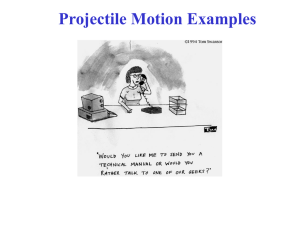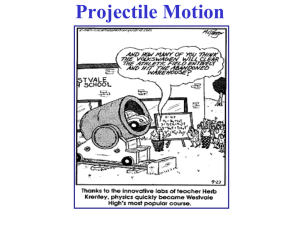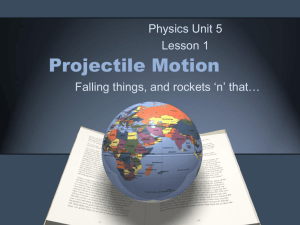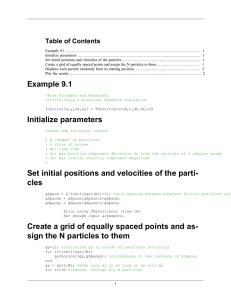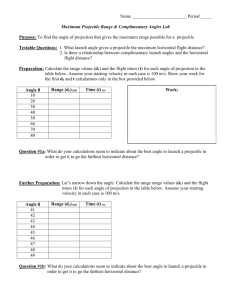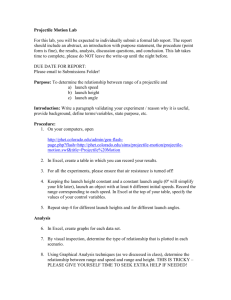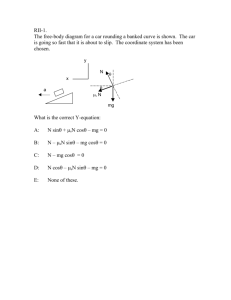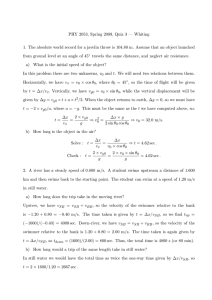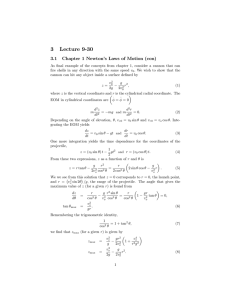Projectiles - TeacherWeb
advertisement
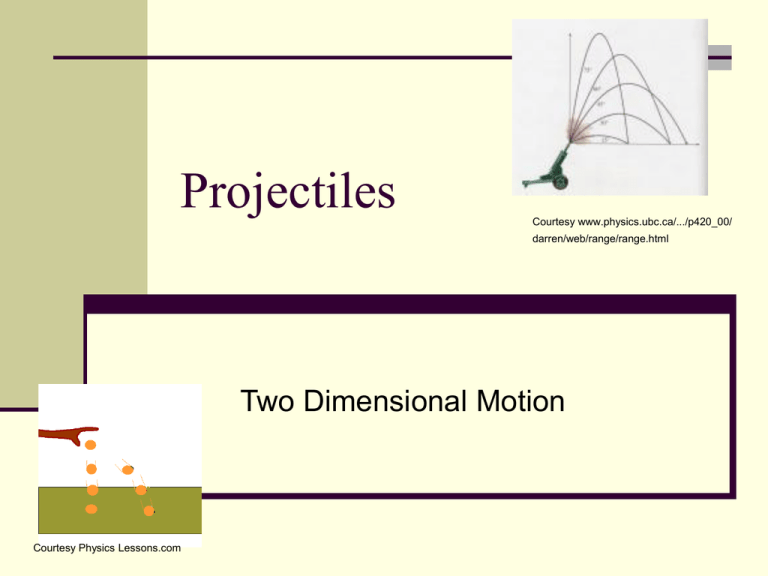
Projectiles Courtesy www.physics.ubc.ca/.../p420_00/ darren/web/range/range.html Two Dimensional Motion Courtesy Physics Lessons.com What’s a Projectile? An object moving in two dimensions under the influence of gravity alone. You Predict Two identical balls leave the surface of a table at the same time, one essentially dropped the other moving horizontally with a good speed. Which hits the ground first? Courtesy of www.mansfieldct.org/schools/ mms/staff/hand/drop.jpg Galileo’s Analysis Horizontal and vertical motions can be analyzed separately Ball accelerates downward with uniform acceleration –g Ball moves horizontally with no acceleration So ball with horizontal velocity reaches ground at same time as one merely dropped. Courtesy Glenbrook South Physics, Tom Henderson Equations Horizontal vx = vx0 x = x0 +vx0t Vertical vy = vy0 –gt y = y0 + vy0t – 1/2gt2 vy2 = vy02 -2gy Assuming y positive up; ax = 0, ay = -g = - 9.80 m/s2 Problem Solving Read carefully Draw Diagram Choose xy coordinates and origin Analyze horizontal and vertical separately Resolve initial velocity into components List knowns and unknowns Remember vx does not change vy = 0 at top Examples Horizontal launch Student runs off 10m high cliff at 5 m/s and lands in water. How far from base of cliff? y = -1/2gt2 (with y up +) time to fall t = (2y/-g)1/2 = (-20/-9.80) 1/2 = 1.43 s x = vx0t = 5 x 1.43 = 7.1 m Extension How fast would the student have to run to clear rocks 10m from the base of the same 10m high cliff? Again t = (2y/-g)1/2 = 1.43 s x = vx0 t vx0 = x/t = 10m / 1.43s = 7.0 m/s Upwardly Launched Projectile With Velocity v and Angle q vx0 = v0cosq vy0 = v0sinq Time in air = 2 vy0/g Range = R = vx0t = v0cosq x 2 vy0/g = (2v02/g) sinqcosq = (v02 /g )sin2q This is Range Formula v 0 Only for y = y0 Gunner’s version sin2q = Rg/v02 Trigonometric identity: 2 sinqcosq = sin2q q R Questions What is the acceleration vector at maximum height? 9.80 m/s2 downward at all times How would you find the velocity at a given time? Use kinematics equations for vx and vy , then find v by sqrt sum of squares of them. How would you find the height at any time? Use kinematics equation for y How does the speed at launch compare with that just before impact? Same Longest Range What angle of launch gives the longest range and why? Assume the projectile returns to the height from which launched. 45 degrees; must maximize sin2q; maximum value of sine is one, happens for 900; then q = 450 If a launch angle q gives a certain range, what other angle will give the same range and why? Hint: R goes as sinqcosq Moving Launch Vehicle If ball is launched from moving cart, where will it land? Simulation Link to simulation Virtual Lab A Punt Football kicked from 1.00 m above ground at 20.0 m/s at angle above horizontal q0 = 370 . Find range. Can we use range formula? No. It doesn’t apply since y ≠ y0 Let x0 = y0 = 0 y = -1.00 m Vy0 = v0sinq = 20 x 0.6 = 12m/s Note: Projectile motion is parabolic Punt, continued Find time of flight using y = y0 + vy0t – 1/2gt2 -1.00m = 0 + (12.0m/s)t – (4.90 m/s2)t2 (4.90 m/s2)t2 - (12.0m/s)t – (1.00m) = 0 t = 2.53s or -0.081 s (impossible) x = vx0t = v0cos370 t= (16.0 m/s)(2.53s) = 40.5 m Using Formulas Be sure the formula applies to the situation – that the problem lies within its “range of validity” Make sure you understand what is going on.

